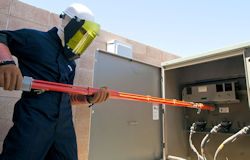Safe Work Practices
To work on or near live parts, you must do the following:
- Have a written live-work permit for the work to be done.
Wear the right PPE to protect against electric shock and arc flash. Never wear clothing made from synthetic materials, such as acetate, nylon, polyester, polypropylene, or rayon—alone or combined with cotton. Such clothing can burn and melt into your skin.
The PPE that is needed depends on the type of electrical work being done. The minimum PPE required while working on line circuits is an untreated natural fiber long-sleeve shirt and long pants, plus safety glasses with side shields. Depending on the voltage and the electric task to be done, different types of PPE are required.
Fire-resistant protective clothing can include a multi-layer flash suit jacket and pants, a wraparound face shield, a double-layer switching hood, voltage-rated gloves with leather protectors, an electrically rated hard hat, and so forth.
- Use the proper type of protective equipment, such as insulated tools and/or handling equipment that is rated for the voltage. These can include insulated fuse or fuse-holding equipment, nonconductive ropes and handlines, fiberglass-reinforced plastic rods, nonconductive portable ladders (such as fiberglass), protective shields, rubber insulating equipment, voltage-rated plastic guards, and so forth.
Knowledge Check Choose the best answer for the question.
8-5. Synthetic clothing is dangerous when working on live parts because _____.
You forgot to answer the question!

